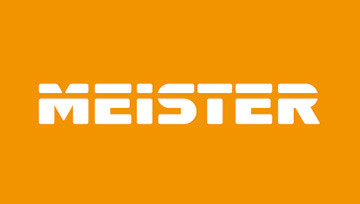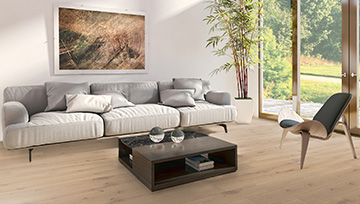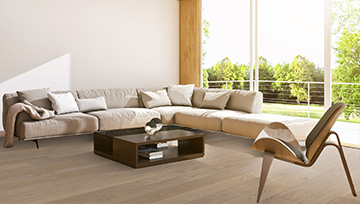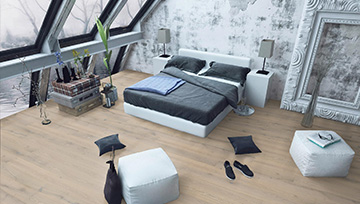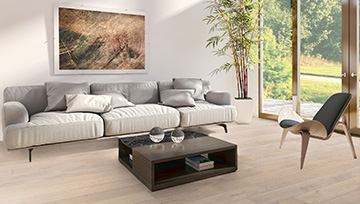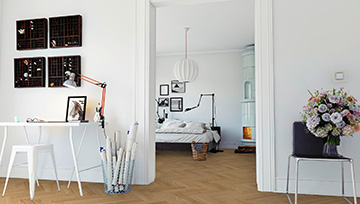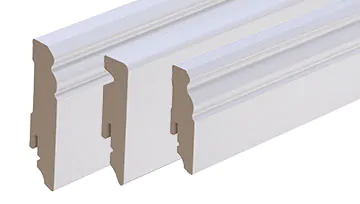Meister parquet flooring
Parquet flooring from the Meister company, this is flooring of the extra class!
Design your living space with natural flooring made of oak, larch, maple, walnut or beech. You are guaranteed to find the parquet of your choice in our wide range of products! Floor coverings from Meister stand for highest quality, best workmanship and long durability. Meister pre-finished parquet is pure nature! You get Meister parquet in oak, maple, beech, larch. Real wood forms the basis for the exclusive, natural floor covering. You can also get ship flooring and country house floorboards of the Meister brand from us.
What distinguishes Meister parquet from other floor coverings?
Meister Parkett bears the name "Longlife Parquet" and for good reason. The parquet convinces by its particularly long durability. Its special equipment with a stable middle layer of HDF (high density fiberboard), a highly compressed fiberboard, makes the parquet flooring insensitive to pressure. This equipment means that Meister's finished parquet is significantly more resistant than conventional parquet with a middle layer of spruce wood. The HDF middle layer increases the weight of the Longlife parquet, which has a positive effect on the laying properties.
Meister pre-finished parquet for an optimal room climate
For a feel-good climate at home, there is nothing better than parquet made of real wood. Wood regulates the humidity in the room in a natural way and improves the room climate. The natural raw material and the HDF middle layer of the parquet have a positive effect on the acoustics.
The maintenance properties of Meister parquet
You will receive the parquet from Meister oiled or lacquered in matt or high gloss. No matter which surface treatment you choose, Longlife parquet from Meister is wonderfully easy to maintain.
Master Longlife Parquet, a contribution to the protection of the environment
The careful use of natural resources is of outstanding importance at Meister. All processes and all materials used in the production of Meister floor coverings are subject to regular inspections. In the development of the parquet flooring in the Longlife series, it has been possible to save around ten percent natural wood with maximum quality and durability thanks to the innovative middle layer made of HDF.
Is parquet from Meister suitable for rooms with underfloor heating?
The combination of underfloor heating and real wood parquet forms the basis for a comfortable climate in the apartment. The Meister Longlife parquet can be easily laid on underfloor heating systems, it conducts the heat excellently. The highly compressed middle layer minimises air inclusions, which can have a heat insulating effect with conventional parquet. Enjoy the full living comfort of underfloor heating and real wood with optimized heating costs!
Master real wood parquet in large selection?
Our product range includes Meister pre-finished parquet in various wood species. Select your favourite:
- Maple
- Beech
- Oak
- Larch
With Meister floor covering for individual furnishing
Not only the type of wood, but also the surface treatment has a decisive influence on the effect of the parquet. Brushing the surface of the wood, for example, results in the natural structure of the wood becoming more visible. On limed surfaces, on the other hand, the wood pores are coloured. This results in surprising effects at Meister Parquet in oak, maple, larch or beech. See for yourself, the unique effect of the different variants and create a high-quality interior with style and creativity. Various laying patterns offer even more possibilities. Herringbone, cube or ladder patterns leave nothing to be desired in terms of stylish, creative and modern interior design.
Master Parquet is environmentally friendly
The "Blue Angel" award gives you the assurance that this parquet is low-emission. The "FSC seal" documents the origin of the wood from sustainable forestry. Through the "REAL WOOD seal" it is guaranteed that the parquet is made of real wood. "Made in Germany" means that the production is really controlled.
The laying direction of the parquet as a design element
The floor plays an important role in the design of a room. Here you probably think first of the type of wood used, the surface finish and the colour of the parquet. Of course all this has a great influence on the effect of the room
But the laying direction of the parquet is just as important. In most cases it is recommended to lay the parquet parallel to the incidence of light. Then joints are less noticeable
If, on the other hand, you want to emphasize the joints, you should lay the Meister parquet across the incidence of light. But what do you do if the room has several windows in different walls? Then lay the parquet parallel to the room diagonal. This creates interesting lighting effects on the floor. Do you want to lay the Meister parquet in a long, narrow room?
Then the laying direction is important. By aligning the parquet lengthwise, the room appears even narrower. It appears wider than it is if you lay the parquet at right angles to the direction of the room. If, on the other hand, the floor is intended for a large room, you may consider using a herringbone pattern.
The different plank formats of Meister parquet
You get the master parquet as:
- Short board
- Long plank
- Tile
- Staff
The short plank is a very variable format and is therefore suitable for many room situations. It is particularly easy to transport and install.
Long planks are more than two metres long. Therefore they are mainly suitable for large rooms. In combination with joints on the long sides, this format offers the perfect illusion of infinitely long planks.
If you like it more modern, tiles might be the right format for you. These can also be laid in small rooms.
For laying patterns - not only the herringbone pattern - the stick format is particularly suitable.
Lacquered or naturally oiled?
Meister parquet is available in the variants "lacquered" or "natural oiled". Both serve to seal the parquet. What's the difference?
A varnish gives the wood a natural, warm appearance. This type of sealing brings out the character of the wood to the full. This treatment makes the floor particularly easy to maintain and hard-wearing. The varnish used consists of ecologically harmless, UV-hardened, formaldehyde-free acrylic varnish.
Natural oils penetrate into the pores of the wood and form a natural, breathable and protective seal. It regulates humidity and supports a healthy room climate. The natural appearance is preserved. The structure of the wood and its grain are emphasized
However, this surface requires regular, adapted care. You can obtain the appropriate care products from the Meister company or from Kaiser Parkett.
What do you have to consider when laying the Meister parquet?
- Parquet is a "breathing" material. This means that the parquet reacts to the humidity and temperature of the environment by absorbing or releasing moisture
It expands or contracts in the process. To prevent this from happening during or shortly after installation, the parquet should be given 48 hours to acclimatise
To do this, lay it flat in the unopened packages in the room where it is to be laid. - Expansion joints around the parquet flooring ensure that no cracks or bulges are caused by the expansion or contraction of the parquet. In order to be able to design these expansion joints evenly, obtain a sufficient number of spacer wedges from your specialist dealer.
- If at least one side of the room is longer than eight metres, you must also allow for expansion joints there.
- For the installation of the parquet, the subfloor must be firm, clean, even and dry. Therefore, they must remove carpets or old carpet. You may have to level the floor with filler or repair cracks before laying the parquet. In any case you should vacuum the surface.
- When installing on a mineral subfloor (screed), you must observe the maximum permissible residual moisture. It depends on the type of substrate and the material of the floor covering. The following values apply to parquet:
Without underfloor heating: Cement flow screed or cement screed: 2 % CM - Calcium sulphate flow screed or calcium sulphate screed: 0,5 % CM
With underfloor heating the values fall to 1.8 % CM and 0.3 % CM
The CM describes the used measuring method for the residual moisture. This information is important because different measuring methods can give different results. Should you find yourself in the situation of having to make use of the manufacturer's warranty, only the CM method will be accepted. - When laying the parquet on a mineral subfloor or over underfloor heating, you must use a vapour barrier, also called a moisture barrier. This is an approx. 0.2 mm thick PE film. It prevents moisture from the subfloor from penetrating into the parquet.
- When laying over underfloor heating, you must ensure that the thermal resistance of the parquet, the vapour barrier and any impact sound insulation together is less than 0.15 Km²/W. The greater the thermal resistance, the better the material insulates against heat. However, this is undesirable in the case of underfloor heating. After all, the heat should pass through the floor covering into the room as unhindered as possible.
- If you want to lay the parquet floating, you need impact sound insulation. When a floor covering is laid as a floating installation, there is a layer of air between the substrate and the floor covering. This acts like a resonance body for the sound and thus amplifies it.
- For a clean design of the transition between two rooms you need either a transition or a compensation profile. If the floor coverings are the same height in both rooms, use a transition profile. If these floor coverings have different heights, you need a compensation profile
Both profiles consist of two parts: the bottom rail and the top rail. The bottom rail must be fitted before the parquet is laid. - You calculate the required amount of parquet by multiplying the length and width of the room. Then add another 5 % to 10 %, because you always have off-cuts when laying. The more angled the room is, the larger the supplement must be.
- To create an attractive transition between the parquet and the wall, use skirting boards in matching colours.


